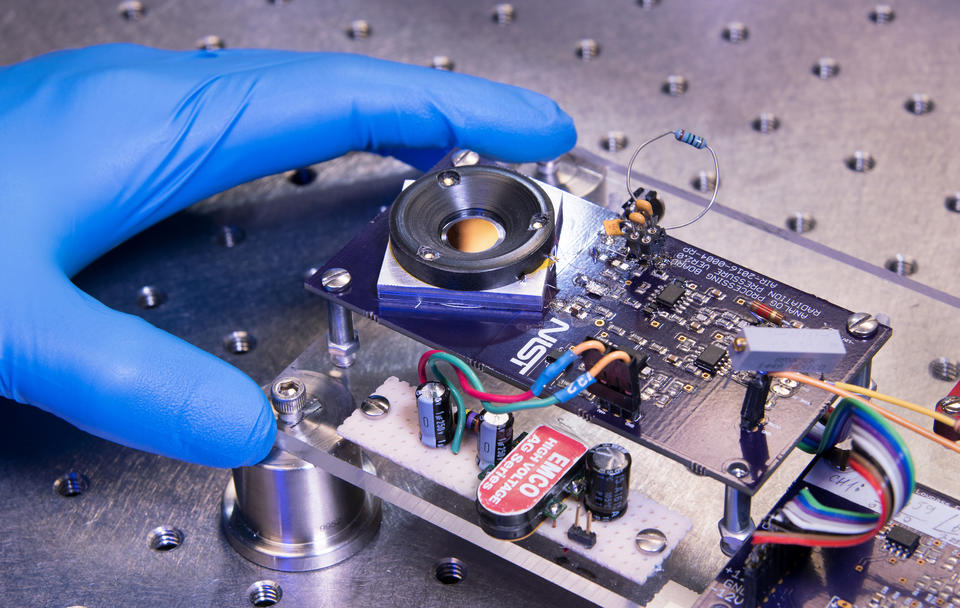Photonic Power Metrology

The Technology
NIST researchers have pioneered a revolutionary technology for measuring large and small quantities of optical power by detecting radiation pressure that light exerts on a mirror.
NIST’s Radiation Pressure Power Meter (RPPM), designed for high-power sources, uses a high-precision laboratory balance with a mirrored surface capable of reflecting 99.999% of the light that hits it. When a laser beam reflects off the mirror, the pressure it imparts is recorded by the balance. The force measurement is then converted to a power measurement.
The higher the power of the laser beam, the more the mirror is displaced. By precisely detecting the amount of that displacement, scientists can sensitively gauge a beam’s power.
The pressures involved can be extremely small. A super-powerful 100 kW beam exerts a force in the range of 68 mg. Measuring radiation pressure accurately at much lower power requires highly sophisticated design and engineering that is continuously being improved.
The original RPPM design is now available from NIST for higher-power lasers. Meanwhile, the NIST team is developing a next-generation instrument called the Beam Box, which will improve upon the RPPM by enabling easy in-line laser power measurements and extending the detection range to lower powers.
Yet another NIST technology in early prototype development is a Smart Mirror, which will further scale down the size of the pressure meter and provide the ability to detect extremely small amounts of power. Ultimately, it will extend exact radiation pressure measurement to the levels exerted by beams of radio waves or microwaves — where there is presently a significant lack of precision measurement capability.
Advantages Over Existing Methods
Higher laser powers have typically been measured by aiming the beam at a quantity of circulating water and detecting the rise in temperature. The water tanks involved can be sizable, and portability is an issue. Calibration often requires transporting the laser to and from a standards lab. Another unfortunate drawback: The detector instrumentation is at risk of being destroyed by the laser beam that it is supposed to measure.
The various NIST radiation pressure models can eliminate those problems and enable accurate power measurements at the user’s site.
Applications
Lasers of various kinds and strengths are everywhere, from pointers to beams for eye surgery and for cutting fabric for clothing and metals for numerous products. They are used in printers, data storage and optical communications; manufacturing applications such as welding; military weaponry and ranging; medical instrumentation; and a host of other applications. The more critical the role that a laser plays, the more urgently necessary it is for its power output to be accurately calibrated.
Key Papers
A.B. Artusio-Glimpse, I. Ryger, N.A. Azarova, P.A. Williams, J.A. Hadler and J.H. Lehman. Miniature force sensor for absolute laser power measurements via radiation pressure at hundreds of watts. Optics Express. April 20, 2020. DOI: 10.1364/OE.385502
P.A. Williams, M.T. Spidell, J.A. Hadler, T. Gerrits, A. Koepke, D. Livigni, M.S. Stephens, N.A. Tomlin, G.A. Shaw, J.D. Splett, I. Vayshenker, M.G. White, C. Yung and J.H. Lehman. Meta-study of laser power calibrations ranging 20 orders of magnitude with traceability to the kilogram. Metrologia. Dec. 20, 2019. DOI: 10.1088/1681-7575/ab4641
J.H. Lehman, K. Rogers, D. Rahn and P. Williams. Inline laser power measurement by photon momentum. Applied Optics. Feb. 6, 2019. DOI: 10.1364/AO.58.001239
P. Williams, A. Artusio-Glimpse, J. Hadler, D. King, T. Vo, K. Rogers, I. Ryger and J. Lehman. Radiation-Pressure Enabled Traceable Laser Sources at CW Powers up to 50 kW. IEEE Transactions on Instrumentation and Measurement. Jan. 4, 2019. DOI: 10.1109/TIM.2018.2886108
C.L. Holloway, M.T. Simons, M.D. Kautz, A.H. Haddab, D. Novotny, J.H. Lehman, P.A. Williams and G.A. Shaw. Using Radiation Pressure to Develop a Radio-Frequency Power Measurement Technique Traceable to the Redefined SI. Applied Physics Letters. Oct. 15, 2018. DOI: 10.1063/1.5052258
I. Ryger, A.B. Artusio-Glimpse, P. Williams, N. Tomlin, M. Stephens, K. Rogers, M. Spidell and J. Lehman. Micromachined force scale for optical power measurement by radiation pressure sensing. IEEE Sensors Journal. Oct. 1, 2018. DOI: 10.1109/JSEN.2018.2863607
A.B. Artusio-Glimpse, I. Ryger, P. Williams, K. Rogers, D. Rahn, A. Walowitz, J. Lehman. Mechanical characterization of planar springs for compact radiation pressure power meters. SPIE Proceedings Volume 10723, Optical Trapping and Optical Micromanipulation XV. Sept. 7, 2018. DOI: 10.1117/12.2324334
C.L. Holloway, A. Artusio-Glimpse, M.T. Simons, I. Ryger, M. Kautz, K.A. Rogers, A.H. Haddab, P.A. Williams, S.W. Nam and J.H. Lehman. Measurement of Radio-Frequency Radiation Pressure: The Quest for a NEW SI Traceable Power Measurement. Proceedings of the 2018 International Symposium on Electromagnetic Compatibility (EMC Europe 2018). Aug. 27-30, 2018. DOI: 10.1109/EMCEurope.2018.8485182
Key Patents
J. Lehman et al. Optical meter and use of same. United States Patent US 9,625,313. April 18, 2017.
J. Lehman et al. Photon momentum sensor. United States Patent US 10,234,309. March 19, 2019.
Contacts
-
(303) 497-3654

